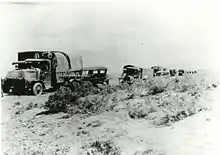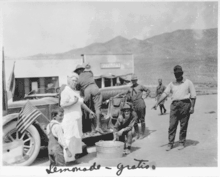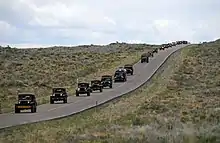Transcontinental Motor Convoy
The Transcontinental Motor Convoys were early 20th century vehicle convoys, including three US Army truck trains, that crossed the United States (one was coast-to-coast) to the west coast. The 1919 Motor Transport Corps convoy from Washington, D.C., to San Francisco used the incomplete Lincoln Highway.

Background
.jpg.webp)
The United States' Good Roads Movement of the late 19th century began as increased use of bicycles required better surfaces over the existing wagon and carriage roads. The development of the automobile and their increased use resulted in the formation of the United States Good Roads Association and various individual cross-country trips by individual vehicles, followed by the first transcontinental trip by a convoy of vehicles.
| Date | Event |
|---|---|
| 1907 | 1st US Army truck purchase.[2] |
| 1911 | The Boy Scouts created the Automobiling merit badge. |
| 1912 | Packard truck carried 3 tons from New York to San Francisco. |
| 1912 | The United States Good Roads Association was formed. |
| 1913-07-28 | US Army Alaska expedition used a White Motor truck. |
| 1914-11 | The Army reported 1½ ton trucks as superior to 2½ ton trucks. |
| 1915-08-25 | Transcontinental motor convoy by film crew.[3] |
| 1916-07-11 | 1st Federal highway funding legislation (five year plan). |
| 1917-07-04 | Flagpole memorial placed at west Lincoln Highway terminus. |
| 1917-12 | US Army convoy from Detroit to an "Atlantic Coast port" |
| 1918-06-02 | The US Army School for Truck Drivers had "just opened".[4] |
| c. 1918 | Chicago-to-New York City convoy set Army distance record.[5] |
| 1918-11-11 | Germans sign an Armistice (cease fire) agreement, ending WWI |
| 1918-12-01 | 90,727 WWI trucks had been produced for the Army & Navy. |
| 1919-03-27 | The Ship-by-Truck Association was formed |
1915 transcontinental film convoy
The 1915 transcontinental film convoy was a 4-month motor convoy beginning August 25 and ending at the Panama–Pacific International Exposition in San Francisco.[6] The film crew completed the "Three-Mile Picture Show" (named for the length of film).[7] The film was directed by Henry Ostermann, Consul at Large for the Lincoln Highway Association,[8] who travelled in a Stutz touring car.[9][10]
The last known existing copy of "The Three Mile-Picture Show" was in the film storage vaults of The University of Michigan, having been donated to the University by Henry Ostermann, and his associate, Gael Hoag. In 1957 the University was contacted by Walt Disney Productions, who wanted to use a part of the film in their movie "The American Highway". When the University Of Michigan inspected the film for the first time since the 1920s, they found it very deteriorated, and very flammable. They shipped the dangerous film to Disney, who, sadly, only wanted a few "humorous" moments to use in their movie, "The American Highway" (1958). After discussion between The University Of Michigan and film restorers, this copy of "The Three-Mile Picture Show" was then said to have been destroyed.
1919 Motor Transport Corps convoy

The 1919 Motor Transport Corps convoy was a "Truck Train"[1] of the US Army Motor Transport Corps that drove over 3,000 mi (4,800 km) from Washington, D.C. (departing July 7 and arriving September 6), to Oakland, California, and ferried to San Francisco. In addition to 230 road incidents[11] (stops for adjustments, extrications, breakdowns, & accidents) resulting in 9 vehicles retiring,[12] the convoy of "24 expeditionary officers, 15 War Department staff observation officers (e.g., Bvt Lt Col Dwight D. Eisenhower of the Tank Corps), and 258 enlisted men" had 21 injured en route who did not complete the trip.[N 1] Although some "were really competent drivers" by the end, the majority of soldiers were "raw recruits with little or no military training"; and except for the Motor Supply Company E commander (1st Lt Daniel H. Martin), troop officers had "meager knowledge" of "handling men in the field".[13]:6,10 [lower-alpha 1] [lower-alpha 2]
The route taken by the convoy began at the Zero Milestone in Washington DC. The convoy proceeded to Gettysburg, where it met up with the Lincoln Highway. They then followed the Lincoln Highway all the way to San Francisco.
The convoy broke and repaired[14] 88 wooden bridges[12]:10 [lower-alpha 3] (14 in Wyoming),[15] and "practically" all roadways were unpaved from Illinois through Nevada.[1]:4 The convoy logged 3,250 miles (5,230 km) in 573.5 hours (5.67 mph avg.).[16] and 6 rest days without convoy travel were used. Convoy delays required extra encampments and, at Oakland, California, the convoy was 7 days behind schedule, ferrying the next morning on the last travel day.[13]:4 [17]
1919 Air Service Transcontinental Recruiting Convoy
The 1919 Air Service Transcontinental Recruiting Convoy[18] was a "mobile army post" of over 1/2 mile long[19] to support 13 aircraft from Hazelhurst Field to California beginning August 14, 1919.[20] The mission of the All American Pathfinders was "to secure accurate information to be used in connection with the carrying of mails by airplanes, and for military purposes, as well as commercial purposes."[19]
1920 Motor Transport Corps convoy
The 1920 Motor Transport Corps convoy left Washington, D.C. on 14 June 1920 and followed the Bankhead Highway to San Diego, California, where it arrived on 2 October. A smaller expedition than the first, the second convoy consisted of 50 vehicles, 32 officers, and 160 enlisted men under Col John F. Franklin. A rate of 45–60 miles per day was initially estimated, commensurate with that of the first convoy.
The convoy's trip proceeded smoothly as far as Atlanta. However, as it moved west into Tennessee, its progress slowed. Detours became necessary due to flooding and the crossing of the "black gumbo" of the Mississippi River proved very problematic. Despite high hopes, the Southern United States proved to be the worst part of the trip. The convoy encountered almost impassable sands between Maricopa and Wellton, Arizona.
Like the first convoy, at every stop the expedition was met by local celebrations and dances. After 111 days and an average rate of less than 30 miles per day, the convoy reached the West Coast where an officer's banquet was given in San Diego. After its arrival in San Diego, the convoy then went north to Los Angeles and was broken up, its equipment distributed to California's public services as part of a program to make use of war surplus.[21]
The officers of the expedition became convinced by their experience that the maintenance of a national highway system should be the province of the federal government, as supported by the Townsend Bill.[13] However, despite the widespread friendly greetings received by the convoys across the nation, neither generated enough public support to ensure passage of the Townsend Bill, which failed and was replaced by the Federal Highway Act of 1921. Both the 1919 and 1920 convoys are identified on the Zero Milestone on the Ellipse in Washington, D.C.
2009 commemoration of 1919 convoy

In the summer of 2009, on the 90th anniversary of the original trek, the Military Vehicle Preservation Association[22] sponsored a re-enactment of the 1919 convoy. Beginning June 10, following the original route as much as possible and duplicating the original schedule, the convoy set out from Washington, D.C. Over the length of the convoy, more than 150 historic military vehicles,[23] including fifty military jeeps, nineteen ¾ ton trucks, seven 1½ ton trucks, six 2½ ton trucks, three cargo trucks, nine motorcycles, and four sedans took part. The oldest vehicle to take part was a 1917 Four Wheel Drive Model B 3 ton ammunition truck.[22]
The reenactors had three purposes: along with retracing the route of 1919 convoy over the historic Lincoln Highway, they paid tribute to the U.S. military and commemorated the 200th anniversary of the birth of President Abraham Lincoln.[23]
2019 commemoration of 1919 convoy
In August and September of 2019, on the 100th anniversary of the original trek, two touring groups commemorated the centennial of the 1919 tour. First, the Military Vehicle Preservation Association sponsored a re-enactment of the 1919 convoy as they did in 2009. The second tour was made by members of the Lincoln Highway Association. Both tours started in Washington, DC and ended in San Francisco.
Notes
- Contemporary sources differ on the number of official observers. Lt. Jackson's official report lists 17 observers by name while the "Principal Facts" monograph states there were 15 observers without naming them.[12]
- List of control points with dates and mileages, p. 5: List of officers, p. 8: List of vehicles & trailers, p. 31: Appendices, pp. 60–80: Daily Log
- also published in Mechanical Eng., vol. 42, no. 3, March 1910, pp. 145–150 and 205, 16 figs. Note: The p. 2 Frederick, Md listings indicate the table uses the inaccurate title "Scheduled Arrivals" for the locations/dates of Scheduled Departures' (cf. East Palestine listings after the Sewickley delay). Similarly, p. 4 inaccurately indicates the last 3 scheduled listings (i.e., Jackson's retyped schedule has scheduled departures from Stockton 8/29/19 and 8/30/19, which inaccurately means a different—but unidentified—scheduled destination for the evening of 8/30 was required before the scheduled 8/31/19 rest day and subsequent arrival in San Francisco.
- Page 5 identifies this typescript was written after the permanent "granite and bronze milestone" (authorized 1920, dedicated 1923) had been placed; and repeated use of "Air Corps" further indicates it was written after the 1918 Air Service became the 1926 Air Corps.
References
- Eisenhower, Bvt. Lt. Col. Dwight D. (November 3, 1919). "…Trans-Continental Trip" (Report - FHWA transcription of typescript). Rock Island Arsenal. Archived from the original on November 18, 2010. Retrieved 2011-03-31.
- "Truck Makers Supply Both Men and Cars for Army" (PDF). The New York Times. March 19, 1918. Retrieved 2011-04-02.
- Patrick, Kevin J; Wilson, Robert E (August 2002). "The Lincoln Highway Resource Guide". National Park Service. Archived from the original on 2011-02-09. Retrieved 2011-04-03.
- "Army and Navy Notes" (PDF). The New York Times. June 2, 1918. Retrieved 2011-04-03.
- "Motor Truck Caravan to Cross Continent" (PDF). The New York Times. July 6, 1919. Retrieved 2011-04-02.
General Charles B. Drake, chief of the Motor Transport Corps … This trip over the Lincoln Highway is in a measure the War Department's contribution towards the good roads cause
- "1915--The Lincoln Highway Goes Hollywood--1915". Lincoln-Highway-Museum.org. Archived from the original on 2011-07-16. Retrieved 2011-04-12.
- Patrick, Kevin J; Wilson, Robert E (August 2002). "CH19.1". The Lincoln Highway Resource Guide. National Park Service. Archived from the original on 2011-02-09. Retrieved 2011-04-03.
- "Travel Over Lincoln Highway Fast Increasing" (PDF). The New York Times. August 15, 1915. Retrieved 2011-04-11.
At desert points such as Fish Springs, Utah, ... the increase in tourist volume ... from two cars a day in 1913 to eight, nine and ten cars a day on the average in 1915. ... Lincoln Highway motion picture film caravan
- "Cover" (PDF). The Traveler. California Chapter: Lincoln Highway Association. 9 (2). April 2008. Archived (PDF) from the original on 2011-05-15. Retrieved 2011-04-12.
- "Lincoln Memorial To Be Scene of Film Feature". The Star and Sentinel. May 22, 1915. Retrieved 2011-04-12.
for photographing the Lincoln mounment [sic] in the upper end of the National cemetery and as the picture is being taken a number of colored residents of town will pass before it and each will lay a wreath of flowers on the monument of the emancipator of their race.
- Pfeiffer, David A (Summer 2006). "Ike's Interstates at 50: Anniversary of the Highway System Recalls Eisenhower's Role as Catalyst". Prologue. Vol. 38 no. 2. Archived from the original on 2011-05-21. Retrieved 2011-03-21.
Motor Transport Corps S.P.U. 595 [sign in photo] …west of Grand Island, Nebraska, soldiers use a winch to pull a Class B truck out of a ditch. Lt. Col. P. V. Kieffer surveys the scene. (Eisenhower Library)
- "Principal Facts Concerning the First Transcontinental Army Motor Transport Expedition" (Briefing fact sheet). Archived (PDF) from the original on 2010-12-06. Retrieved 2011-04-06.
Briefed from the official report compiled by William C. Greany … departed from the temporary Zero Milestone
- Jackson, 1st Lt Elwell R (October 31, 1919). …First Transcontinental Motor Convoy (PDF) (Report). pp. 2–4. Archived (PDF) from the original on December 6, 2010. Retrieved 2011-03-21.
- "Dusty Doughboys on the Lincoln Highway: The 1919 Army Convoy in Iowa". Palimpsest. Vol. 58 no. 3. May–June 1975. Archived from the original on 2010-04-01. Retrieved 2011-03-25.
…Marshalltown, and Jefferson offered earlier in the week. … The convoy broke, and repaired, nearly 100 bridges.
- Donnelly, Jim (November 2005). "Dwight D. Eisenhower". Hemmings Classic Car. Retrieved 2011-03-21.
- Daily Log of the First Transcontinental Motor Convoy (Report). pp. 60–82.
Ordnance Observer returned to Canton … to investigate accident… Returning, we caught up with Convoy
- CriticalPast 1919.
- "Army Orders" (PDF). The New York Times. July 23, 1919. Retrieved 2011-04-06.
Grower, 1st Lt. R. W., to Hazelhurst Field, to accompany the Air Service Transcontinental Recruiting Convoys, then to station in this city.
- "Flying Circus of All America Coming to Montana" (Google News Archive). The Times-Optimist. Gilman, Montana. September 12, 1919. Retrieved 2011-04-06.
- "Weather Delays Flight to Coast; Squadron of Pathfinders Will Start on Transcontinental Trip Today. Plane Bids City Good-Bye Dance to Tunes from Radio Telephone as Craft Circles OverTimes Building" (PDF). The New York Times. August 14, 1919.
- Weingroff, Richard F. (April 7, 2011). "Zero Milestone - Washington, D.C." Highway History. Federal Highway Administration. Archived from the original on July 16, 2012. Retrieved May 23, 2012.
- "Convoy Participants" (PDF). Military Vehicle Preservation Association. February 2009. Retrieved 2009-05-21.
- Locher, Paul (April 27, 2009). "Historic Military Vehicles Rolling into Area". The Daily Record. Wooster, Ohio. Archived from the original on July 16, 2011. Retrieved 2009-05-21.
- CriticalPast (1919). "U.S. Army motor transport convoy in Oakland and San Francisco after Transcontinental Motor Convoy trip across America in 1919". criticalpast.com. Retrieved September 6, 2019.CS1 maint: ref=harv (link)
Further reading
- Steven J. Bucklin, "Who needs roads?" South Dakota History (2016) 46#4 pp 287–325.